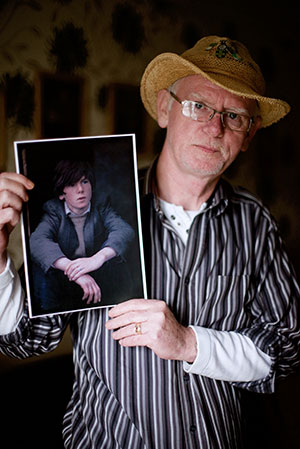RTÉ1, 28 September, 5 and 12 October 2016
By John Gibney
John Connors: The Travellers begins with the eponymous presenter recounting a range of pejorative terms that might be used against Travellers before pointing out that all of them have equally been used in the past against the Irish as a whole. It is an arresting opening (which makes a fair point) for an impressive three-part documentary that seeks to explore the often-obscure history of Ireland’s Travelling community.
Connors is by this stage best known as the man who finally shot Nidge in Love–Hate. A talented actor who has also become a prominent activist for Travellers’ rights, he proves himself to be a capable presenter here. The Travellers is quite a distinctive documentary, as it is also a chronicle of an investigative project into Traveller history being undertaken by the National Folklore Archive in UCD. The National Folklore Commission (NFC) was established in the 1930s, a pioneering initiative to record Ireland’s vernacular culture (cynics who view this as some kind of stroke by Éamon de Valera should note that the outcome is one of the single largest folklore archives in the world, one that is all too often neglected by historians’ focus on more ‘official’ archives). Yet while often innovative in its practices, there were significant gaps in the NFC’s investigations. It did not collect folklore from urban areas (which were not seen as worth bothering with) or in Northern Ireland (a separate jurisdiction), and it did not systematically record material from Travellers. That said, some material was collected from Travellers; music was a particular bridge, as pipers such as Seamus Ennis, who worked as a full-time collector, could use his skills as a musician as a means of reaching out to communities and individuals. Such material as was collected from them and, crucially, about them was not collected by Travellers, which is by no means ideal, as nuance and emphasis can literally be lost in translation. Much of the NFC’s information on Travellers is more revealing about the settled communities’ experience and view of them at particular junctures. The purpose of the project was to address the gap, and to do so by using members of the Travelling community themselves to collect the data. Amongst them was Connors, and the effectiveness of his presentation arose from his active participation behind the scenes, as well as in front of the camera.

This was a very well-made documentary, amply bolstered by archival footage and material, as it followed the interviews conducted by Connors and his fellow researchers. Those showcased in the series were collected from an older generation, which was indeed the point. Irish society has changed dramatically in the past 70 years and the Travelling community has changed as well; this was an attempt to record the traditions of an older layer of Irish Traveller experience before it vanished forever. The 1950s was pinpointed as a key decade here, as urbanisation and economic downturn forced Travellers to migrate to towns and cities in greater numbers than before. This, in turn, saw tensions between Travellers and the authorities increase in subsequent years. The brutal clearance of a Traveller encampment in Dublin’s Cherry Orchard in 1960, for instance, was vividly recalled by one of those present, Kevin Donoghue, who witnessed it as a terrified child. The issue of official discrimination loomed large, with a number of older respondents noting the irony that they faced virtually no discrimination on the grounds of being Travellers whilst in England, where they were all classed as Irish anyway. It was on their return home that they faced problems, and the documentary made it clear that contempt for Travellers in Irish society is very real and of long standing. Yet discrimination is not the whole story that was on display here: recollections of lifestyle, language and music offered a portrait of a vernacular culture that is often overlooked, and many of the older Travellers interviewed were critical of customs such as arranged marriages; there was a good deal of self-reflection here as well.


The third episode offered the most far-reaching, if tentative, set of possible conclusions, as it tackled the big question: who are the Travellers, and where did they come from (a subject tackled in our Winter 2004 issue by Sinéad Ní Shuinéar, who makes a cameo appearance here)? It is often assumed that the Travellers are essentially survivors of the Famine—that having been evicted and having taken to the road, their descendants have remained there ever since. This naturally has implications for their designation as a distinct community. The view that the Travellers were, as one contributor noted ironically, ‘failed settled people’ who needed ‘to be fixed’ had implications for their treatment by the state in independent Ireland, as indicated by the recommendations of the 1963 Commission on Itinerancy, with its assumption that no ‘final solution’—that term was actually used in its report—could be found ‘until itinerant families were absorbed into the general community’; the view of the existence of Travellers as originating in a temporary aberration fitted neatly with this perspective. Yet if this was not the case, then what other possible origins were to be found? The genetic origins of Travellers are in Eastern Europe (though there is no genetic link to the Roma), within peoples who then migrated across the continent, yet DNA patterns indicate that they have been a relatively distinct community in Ireland for a very long time. At some point over the past 500–1,000 years, the ancestors of today’s Travellers seem to have diverged from the bulk of Ireland’s society, possibly due to the brutal pressures of British conquest and colonisation; as Connors rightly points out, these findings are tentative, but they point towards a different reality than the one often assumed. The same could be said of this well-made and fascinating documentary as a whole.
John Gibney is Education and Outreach Officer at Glasnevin Cemetery Museum.
